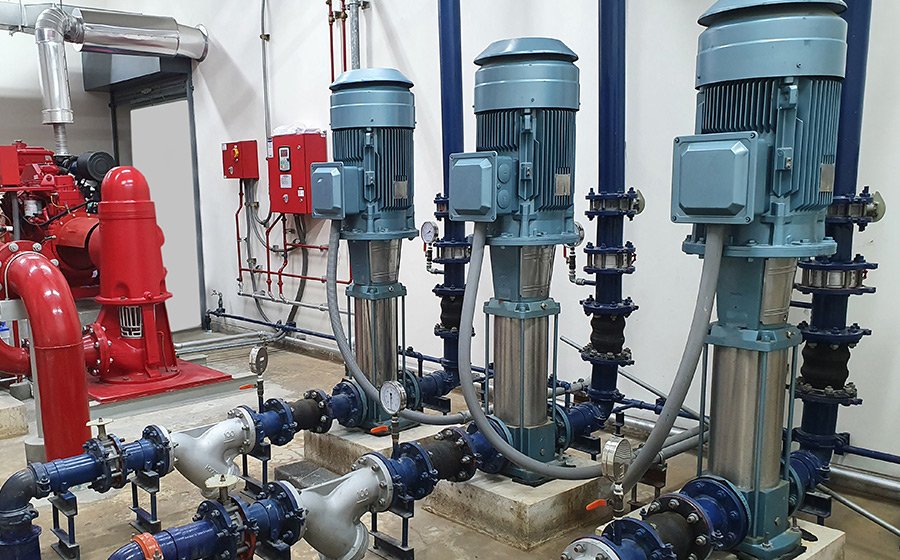Vertical inline centrifugal pumps are integral components in various industrial and commercial applications. These pumps are designed to move liquids efficiently and are favored for their compact design and high performance. Their vertical orientation helps save space, making them ideal for installations where floor space is limited. In this blog, we’ll explore what vertical inline centrifugal pumps are, how they work, their advantages, applications, and maintenance tips. This information will help you understand why these pumps might be the right choice for your needs.
What is a Vertical Inline Centrifugal Pump?
Basic Definition and Function
A vertical inline centrifugal pump is a type of centrifugal pump where the pump shaft is oriented vertically. The pump is called “inline” because the inlet and outlet ports are aligned in a straight line, facilitating a direct and streamlined flow of liquid. This design helps in reducing the footprint of the pump, making it suitable for installations with space constraints. The primary function of this pump is to move liquids from one location to another by converting rotational energy into hydraulic energy through a rotating impeller.
Key Components and Design
The main components of a vertical inline centrifugal pump include the impeller, pump casing, shaft, and bearings. The impeller, driven by the motor, rotates and creates a centrifugal force that pushes the liquid outwards. The pump casing, usually made of durable materials like cast iron or stainless steel, contains the liquid and directs it through the pump. The vertical design allows the pump to be mounted directly onto piping systems, simplifying installation and reducing the need for additional space.
How Does a Vertical Inline Centrifugal Pump Work?
Working Principle
The working principle of a vertical inline centrifugal pump revolves around centrifugal force. When the pump operates, the impeller rotates rapidly, creating a centrifugal force that moves the liquid towards the pump’s outer edge. This movement generates a low-pressure area at the center of the impeller, drawing more liquid into the pump. The liquid is then pushed through the casing and exits through the discharge port. This process efficiently converts the energy from the rotating impeller into kinetic energy, enabling the liquid to be transported through the system.
Flow Dynamics and Efficiency
The flow dynamics of a vertical inline centrifugal pump are designed to optimize efficiency and performance. The inline design ensures a smooth and uninterrupted flow of liquid, reducing turbulence and energy loss. The vertical orientation also helps in minimizing the space required for the pump, allowing for more efficient use of available space. Additionally, the pump’s impeller and casing are engineered to provide a high level of hydraulic efficiency, which translates to better energy utilization and lower operational costs.
Advantages of Vertical Inline Centrifugal Pumps
Space-Saving Design
One of the major advantages of vertical inline centrifugal pumps is their space-saving design. Unlike horizontal pumps, which require a larger footprint, vertical pumps can be mounted directly onto piping systems. This compact design is particularly beneficial in facilities where space is at a premium, such as in commercial buildings or industrial plants. By reducing the amount of floor space needed, vertical inline pumps help in maximizing the usable area and allowing for more flexible equipment placement.
Energy Efficiency
Vertical inline centrifugal pumps are known for their energy efficiency. The streamlined design and optimized flow dynamics reduce energy losses and improve overall performance. These pumps are designed to operate with minimal energy consumption while delivering high flow rates and pressure. The efficient use of energy not only helps in reducing operational costs but also contributes to a more sustainable and eco-friendly operation.
Easy Installation and Maintenance
Another advantage of vertical inline centrifugal pumps is their ease of installation and maintenance. The inline design allows for straightforward integration into existing piping systems, reducing the complexity of installation. Additionally, the vertical orientation simplifies access to key components for maintenance and servicing. Regular maintenance tasks, such as checking the impeller and bearings, can be performed with minimal disruption to the overall system.
Common Applications of Vertical Inline Centrifugal Pumps
Industrial Uses
In industrial settings, vertical inline centrifugal pumps are used for a variety of applications, including water circulation, chemical processing, and cooling systems. Their ability to handle high flow rates and pressures makes them suitable for demanding industrial environments. For instance, these pumps are commonly used in HVAC systems to circulate water through cooling towers and heat exchangers, ensuring efficient temperature control.
Commercial Buildings
In commercial buildings, vertical inline centrifugal pumps play a crucial role in maintaining water supply and pressure. They are used in plumbing systems, fire protection systems, and irrigation systems. The compact design of these pumps makes them ideal for use in buildings with limited space, where they can efficiently manage water distribution and pressure without occupying excessive floor space.
Water Treatment Facilities
Water treatment facilities rely on vertical inline centrifugal pumps for various processes, including filtration, chemical dosing, and sludge handling. The pumps’ efficiency and reliability are essential for maintaining consistent water quality and ensuring the smooth operation of treatment processes. Their ability to handle different types of liquids and contaminants makes them a versatile choice for water treatment applications.
Comparing Vertical Inline Centrifugal Pumps with Other Pump Types
Differences from Horizontal Centrifugal Pumps
Vertical inline centrifugal pumps differ from horizontal centrifugal pumps primarily in their orientation and space requirements. While vertical pumps are oriented upright and have a compact footprint, horizontal pumps are laid flat and require more floor space. The vertical design of inline pumps allows for easier integration into existing piping systems and often results in a more efficient use of space. Additionally, vertical pumps can offer better performance in applications where space constraints are a concern.
Comparison with Submersible Pumps
Submersible pumps are designed to operate underwater, making them suitable for applications where the pump needs to be submerged in the liquid being pumped. In contrast, vertical inline centrifugal pumps are installed above the liquid level and are typically used for surface-level pumping applications. While submersible pumps are ideal for wells and sump applications, vertical inline pumps are more suitable for scenarios where space-saving and efficient flow management are priorities.
Factors to Consider When Choosing a Vertical Inline Centrifugal Pump
Capacity and Head Requirements
When selecting a vertical inline centrifugal pump, it’s important to consider the capacity and head requirements of your application. Capacity refers to the volume of liquid the pump can move per unit of time, while head refers to the height the pump can lift the liquid. Matching these specifications to your system’s needs ensures that the pump will perform efficiently and effectively. Oversizing or undersizing the pump can lead to performance issues and increased operational costs.
Material and Build Quality
The material and build quality of a vertical inline centrifugal pump are critical factors that impact its durability and performance. Pumps are typically made from materials such as cast iron, stainless steel, or bronze, each offering different levels of corrosion resistance and strength. Choosing the right material based on the type of liquid being pumped and the operating environment is essential for ensuring the pump’s longevity and reliability.
Cost and Energy Efficiency
Cost and energy efficiency are important considerations when selecting a pump. While initial cost is a significant factor, it’s also crucial to consider the long-term operational costs, including energy consumption and maintenance. Vertical inline centrifugal pumps are designed to be energy-efficient, which can help in reducing overall operating costs. Evaluating the total cost of ownership, including both upfront and ongoing expenses, will help in making an informed decision.
Maintenance Tips for Vertical Inline Centrifugal Pumps
Regular Checks and Servicing
Regular maintenance is essential for ensuring the reliable operation of vertical inline centrifugal pumps. Routine checks should include inspecting the impeller for wear, checking the condition of the bearings, and ensuring that all connections and seals are intact. Scheduled servicing helps in identifying potential issues early and prevents unexpected breakdowns. Keeping the pump clean and free from debris also contributes to its optimal performance and longevity.
Troubleshooting Common Issues
Common issues with vertical inline centrifugal pumps include reduced flow rates, unusual noises, and leakage. Reduced flow rates can be caused by clogged filters or worn impellers, while unusual noises may indicate problems with the bearings or shaft alignment. Leakage can result from damaged seals or connections. Troubleshooting these issues involves inspecting the pump components, addressing any damage or wear, and performing necessary repairs or replacements.
Conclusion
Vertical inline centrifugal pumps offer numerous benefits, including space-saving design, energy efficiency, and ease of maintenance. Their versatility makes them suitable for a wide range of applications, from industrial processes to commercial plumbing and water treatment facilities. By understanding the key features and considerations associated with these pumps, you can make informed decisions and ensure that your pumping systems operate efficiently and effectively. Whether you’re dealing with water circulation, chemical processing, or building maintenance, vertical inline centrifugal pumps provide reliable performance and optimal functionality.




